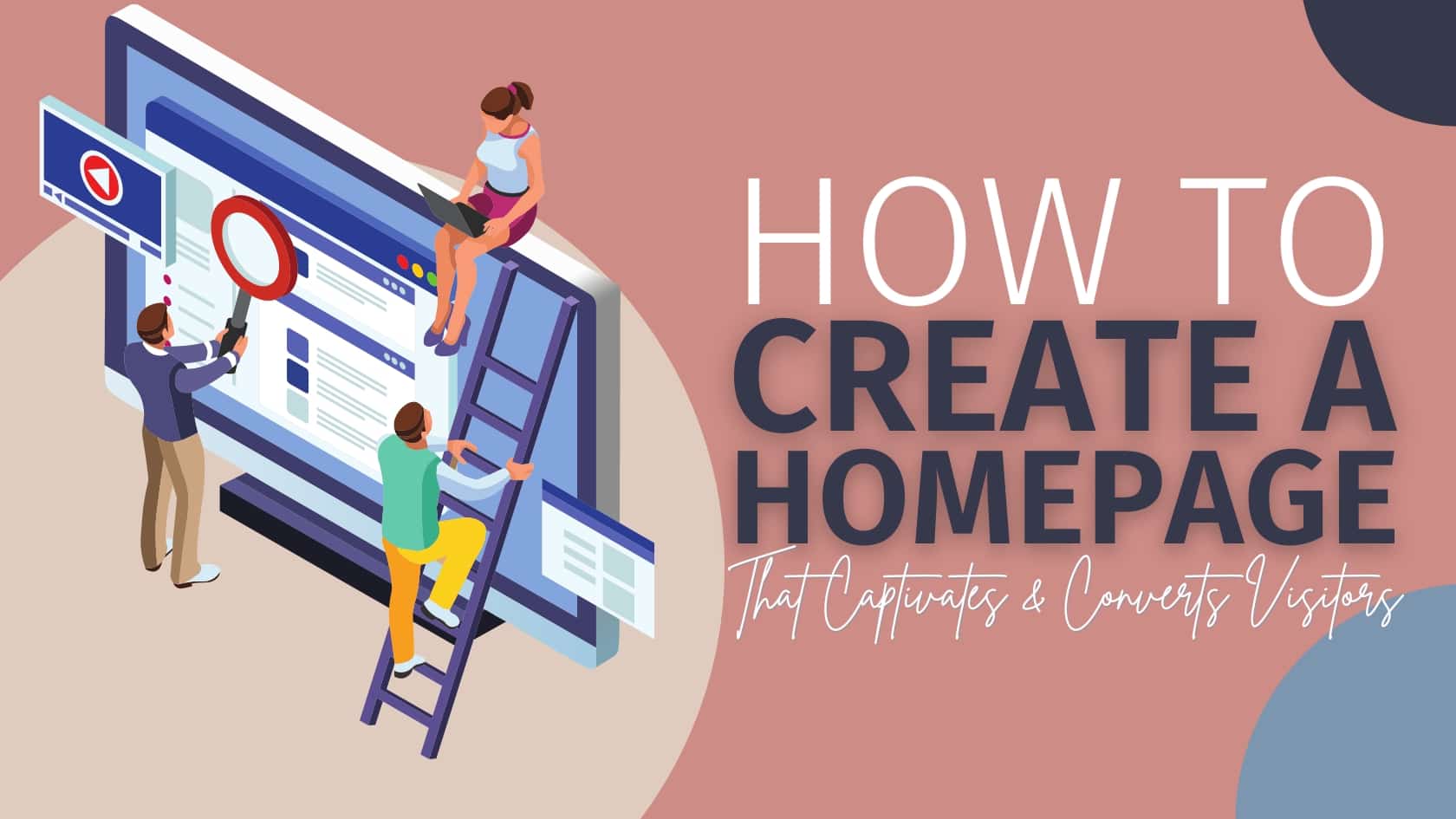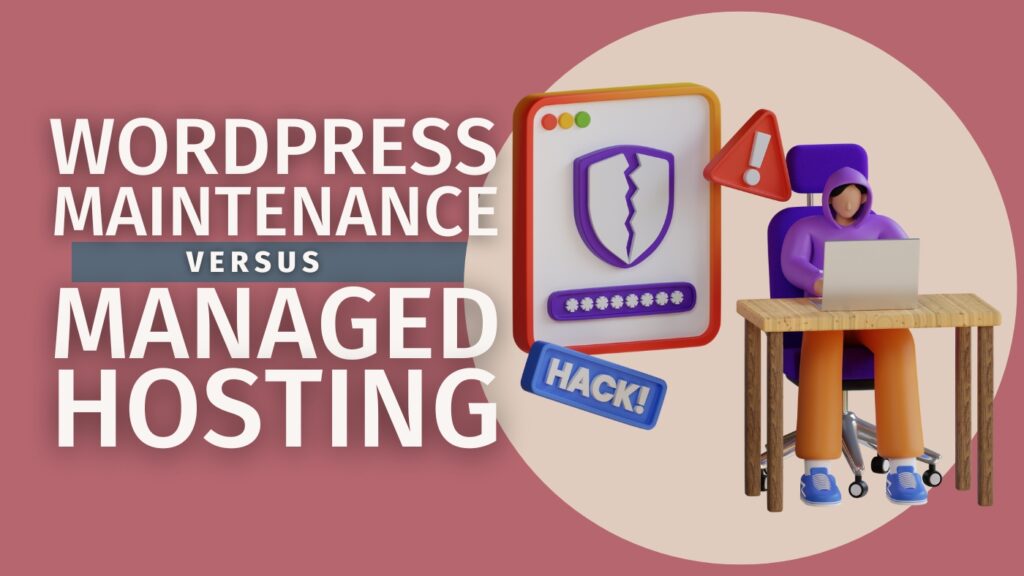How To Create a Website Homepage That Hooks Visitors

Written By: TaKenya
Published: January 22, 2024
Modified: September 3, 2024

The links in this post may be affiliate links. That means that if you click them and make a purchase, this site makes a commission. It will have no impact on the price you pay or the experience of your purchase.
A captivating homepage is crucial for your business. It hooks visitors, leads to conversions and customer loyalty. Let’s explore how to create one.
Your website is often the first interaction potential customers have with your business. Therefore, it is crucial that your homepage, the digital “front door” to your business, engages visitors and encourages them to explore further.
A well-crafted homepage can hook visitors and leave them wanting more, ultimately leading to conversions and customer loyalty.
Let’s explore how to create a homepage that captivates your audience and keeps them coming back for more. And MORE!
Understanding the Importance of Your Homepage
Imagine walking into a physical store. The storefront, display windows, and entrance play a pivotal role in influencing your first impression, don’t they?
The same concept applies to your website’s homepage.
This is where your potential customers get their first taste of your brand.
It’s more than just a digital welcome mat. It’s your opportunity to capture interest, tell your brand’s story, highlight your unique value, and guide visitors toward a specific goal.
Be it buying a product, subscribing to a newsletter, reading content, or reaching out for more details.
A captivating homepage can be your secret weapon for customer attraction and retention if done right. So, let’s take a closer look at how you can transform your homepage from a mere landing page to a powerful conversion tool.
Defining Your Website’s Purpose and Goals
You’re not building a website just for the sake of it, right?
There’s a reason, a purpose.
Whether that’s to generate leads, sell products, share information, or establish a powerful online reputation. Identifying this from the outset is vital.
It’s like setting the compass for your digital journey, directing the course of your content and design choices.
Once you have a clear understanding of your site’s mission and objectives, you can ensure every component of your homepage is pulling in the same direction.
Building a digital platform that perfectly complements and enhances real-world operations is about creating harmony between your website and business goals.
Having a clear purpose and goals is key to designing a homepage that looks great AND performs effectively.
How can I determine my website’s purpose and goals in order to create a homepage that hooks visitors?
Start by stepping back and analyzing the core function of your business.
Is it to sell a product, provide a service, share knowledge, or something else entirely?
Your website’s purpose should align with this.
To understand your goals, identify the actions you want visitors to take on your site.
Do you want them to make a purchase, sign up for a newsletter, or contact you for a quote?
These are your website’s goals.
To drill down further, consider your target audience.
- What are their needs and wants?
- What would entice them to take the actions you desire?
These insights can shape your content and design decisions, ensuring your homepage truly resonates with your audience.
Essentially, it’s about defining your “why,” “who,” and “what”.
- Why does your website exist?
- Who is it for?
- What do you want them to do?
Answering these questions can help carve out a clear, compelling homepage strategy.
Keeping the Design Simple and Clean
When it comes to designing your website’s homepage, it’s best to keep it simple and avoid clutter.
A site that’s visually overwhelming can be confusing and discouraging to potential clients, making them leave your site.
To create an enjoyable user experience, go for a minimalistic approach that utilizes white space to highlight essential features and guide the visitor’s eye.
Use high-quality images that showcase your brand’s story in a single glance.
Your choice of color palette and typography should reflect your brand’s identity and create a consistent and appealing aesthetic.
A clean, uncluttered design ensures that navigation is easy, and visitors can quickly find what they’re looking for. Remember that your primary goal is to create an attractive design and make it easy for visitors to achieve your website’s ultimate objective.
Whether that’s purchasing a product, signing up for a newsletter, or requesting contact, a simple and sleek design can help visitors stay focused and engaged.
Key Elements of a Captivating Homepage
In creating a website homepage that captivates, consider these crucial elements:
- Clear navigation
- Header
- Gallery/Portfolio
- Connect to Customer Pain Points
- How To Work With You
- Testimonials
- Content Snippets
- Call To Action
- Footer Navigation
When it comes to designing a website homepage, it is crucial to focus on creating a seamless, captivating, and user-oriented experience.
All the different components of the homepage should complement each other, resulting in a persuasive storyline that captures the attention of your visitors and encourages them to take action.
It’s important to keep in mind that creating a website homepage is an ongoing process that requires continuous adjustments and improvements to make it more effective.

Clear Navigation
The top navigation of your website plays a crucial role in setting the tone and helping visitors explore your site easily.
It’s not just a utility tool but also creates a clean and uncluttered first impression. Properly grouping and labeling categories can make navigation intuitive and improve the overall user experience.
Creating an Attention-Grabbing Headline
The power of your website’s headline cannot be overstated. This small collection of words can either make or break your visitor’s decision to explore your website further.
Think of it as a magnetic first impression that encapsulates the essence of what you offer in a memorable, compelling way.
To create a headline that sparks curiosity, it’s important to strike a balance between being informative and intriguing.
This requires clarity, conciseness, and a touch of creativity. To nail this, you should spend time understanding your audience, their needs, and how your offering uniquely fulfills those needs.
Then, encapsulate that into a powerful one-liner that instantly communicates your unique value proposition.
Aim for a headline that engages, inspires action, and leaves visitors eager to learn more about your brand.
Remember, you only have seconds to grab attention in the digital world, so make your headline count.
It’s also important to have a secondary header underneath that expands on what you do and who you serve.
This gives visitors a better understanding of what your website is about and ensures them that they’ve landed at the right place.
According to a Nielsen Norman Group study, users spend approximately 80% of their time on a webpage looking at information above the fold (the top section of a website visible without scrolling).
For example, if you’re a gym, your website might have a header stating “Transform Your Life Today,” with a secondary header explaining “Personalized Fitness Training for All Ages and Fitness Levels.”
This tells visitors immediately that they are in a place that caters to their fitness goals and needs. This clarity in messaging not only establishes the value you provide but also the audience you serve.
This sense of direct communication creates an immediate connection with your target audience, encouraging them to delve deeper into your site.

Showcasing Your Unique Selling Proposition
A homepage that stands out should clearly communicate your Unique Selling Proposition (USP).
This means highlighting what sets you apart from the competition – your unique edge.
Firstly, identify your core benefits, values, and attributes and craft a brief, compelling statement.
It could be your exceptional customer service, cutting-edge products, or innovative approach.
Whatever it is, ensure that it’s conveyed effectively on your homepage.
But it’s not just about telling; you also need to show it. Use testimonials, case studies, or awards to substantiate your claims. Emphasize how you’ve created tangible value for your customers.
Highlight how your offering is not just unique but also beneficial.
Strive to connect with your audience, making sure your USP resonates with their needs, aspirations, and values.
And remember, your USP should be evident throughout your entire homepage, subtly woven into every element, from your headline to your imagery.
If you succeed in showcasing your USP effectively, it can position your brand as the obvious choice in a sea of competitors, attracting visitors and motivating them to explore more.
Do You Need a Portfolio on Your Homepage
The inclusion of a portfolio on your homepage largely depends on the nature of your business. A portfolio is crucial if you’re in a creative field, such as design, photography, or writing.
It acts as a visual resume, showcasing your skills, experience, and style at a glance. Case studies or success stories might serve a similar purpose for other businesses.
These tangible proof points of your work offer a persuasive peek into what you can deliver, stirring trust and interest in your potential customers.
Showcase what you do best in a way that resonates with your target customers, using visuals and narratives that capture attention and build credibility.
Remember, your homepage is your digital shop window. A portfolio is one way to make that view compelling and enticing.
Connect To Customer Pain Points
As a business owner, it’s important to understand your customers’ pain points and provide solutions that address them.
To do this effectively, you need to identify the common struggles your target audience experiences and clearly explain how your products or services can help alleviate these issues.
You can establish credibility and relatability with your customers by telling a story that showcases empathy, expertise, and effective solutions.
For example, if you run a digital marketing agency, you might highlight the challenge many businesses face in reaching their audience online.
Your website can then showcase case studies of how you’ve helped similar businesses grow their digital presence, convert leads, and achieve their business goals.
It’s important to emphasize how your innovative solutions set you apart from competitors, illustrating your unique approach and track record of success.
To make this part of your homepage more engaging, use compelling graphics or animations to create an interactive experience for users.
By doing so, you’ll be able to foster a dynamic user experience that keeps visitors engaged and interested in what you have to offer.
Sharing How To Work With You On Your Homepage
When it comes to working with potential clients, remember that transparency and ease of understanding are key.
By showcasing different ways to work with you and providing clear guidance on the next steps, you can help convert curious visitors into committed customers.
Your “How to Work With Us” section is an opportunity to demystify the journey from visitor to customer, paving a smooth, inviting path that nudges your audience to take that first step towards doing business with you.
By being transparent about pricing, timelines, and expectations, you can build trust and encourage engagement.
So don’t be shy – make it easy and appealing for visitors to engage with your brand and start a journey towards a successful partnership.
Do you need testimonials on your homepage?
Testimonials are an essential tool for building credibility and trust in your brand.
They act as social proof, giving potential customers an insight into the experiences of others who have engaged with your brand.
By highlighting endorsements from clients who reflect your ideal customer profile, you can reassure visitors and build confidence in your product or service.
To maximize the impact of your testimonials, it’s important to keep them short and focused on relatable snippets that resonate with potential customers.
Be sure to get permission from your satisfied clients to feature them on your homepage, including their success stories, results achieved, and quotes from their testimonies.
This will enhance your brand’s credibility and showcase your commitment to client success.
To ensure authenticity, use real words from real customers, ideally with a name, photo, or company logo, for added credibility.
Showcasing these reviews on your homepage, perhaps near your call-to-action, can nudge your visitors closer to conversion.
In an online world where trust can be hard to earn, genuine testimonials can be a powerful tool in your homepage arsenal.
Sharing content on your homepage
One effective way to engage your website visitors is by featuring your recent projects, blog posts, or a freebie.
This will showcase your expertise and provide a glimpse of what you have to offer.
You can add short teasers from your blog or descriptions of your recent projects to pique visitors’ curiosity and demonstrate your active engagement in your field.
Additionally, offering a freebie or incentive can be a powerful conversion tool, giving visitors a risk-free opportunity to experience your work.
Implementing Strong Calls-to-Action
Imagine your website’s calls-to-action (CTAs) as stepping stones that guide your visitors on their journey to becoming customers.
They serve as gentle, persuasive nudges that urge visitors to take the next step, whether that’s signing up for a newsletter, purchasing a product, or scheduling a demo.
The key to effective CTAs is their prominence, persuasion, and simplicity.
Your CTAs should be like friendly, helpful sales assistants, making it easy for your visitors to take the next desired action.
You may want to add a sense of urgency or exclusivity to your CTAs to encourage action.
Remember that every aspect of your CTA, including its color, wording, size, and position, can influence its effectiveness.
So, take the time to craft these conversion catalysts with care, ensuring that they’re an irresistible invitation for your visitors to engage more deeply with your brand.
How can I ensure that my calls to action are strong and effective on my homepage?
The effectiveness of calls-to-action (CTAs) depends on the application of strategic principles.
It is recommended to create visually striking CTAs that are easy to spot.
- Factors such as strategic placement, color contrast, and size can be crucial in grabbing visitor attention.
- The CTA text should be clear, concise, and compelling.
- Using action verbs can prompt quick action, and creating a sense of urgency or scarcity can help.
- It’s better to use personalized CTAs based on visitor behavior or demographics to increase relevance and appeal.
- Lastly, ensuring a smooth transition from the CTA to the next step of the customer journey can boost conversion rates.
- Effective CTAs are crucial steps in the customer’s journey toward conversion.
- Research suggests that websites with strong CTAs are more likely to generate leads and conversions.
- Visitors should be directed towards the CTA, guiding them to the next logical step.
- Choosing an appealing, actionable phrase for the CTA can inspire visitors to take action.
- It can be as straightforward as “Book Now” or as intriguing as “Unleash Your Potential.”

The Footer
Lastly, the footer should include navigation options, enabling visitors to easily access the information they need.
What’s the difference between the header navigation and footer navigation?
The footer navigation typically contains links related to legal and technical information, along with social media accounts.
It acts as a safety net for any critical information that may have been missed in the main content. Unlike the top navigation, the footer navigation serves to conclude the user’s journey.
It makes it easier for visitors to comprehend your company’s practices and how to get in touch after completing their primary exploration.
Think of it as your final opportunity to guide users, answer any remaining questions, and provide the reassurance they may need to stay connected or become customers.
It is crucial to keep your footer clean and well-organized to enhance your visitor’s overall experience.
Website Design Best Practices For Capturing Audience Attention
Crafting a captivating homepage requires the application of a few strategic web design principles.
Understand that visual hierarchy matters
Arrange elements to naturally guide the visitor’s eye towards your most critical information. Use size, color, and contrast to create focal points that attract attention.
For instance, your call-to-action (CTA) should be bold and noticeable, encouraging visitors to interact.
Maintain consistency in your design elements
Consistency, from colors and fonts to buttons and headers, creates a visually pleasing and cohesive experience that puts users at ease.
However, don’t be afraid to break consistency for important elements you want to highlight, like your CTA.
Speed is essential
Slow-loading pages are a surefire way to deter visitors. Optimize your images, streamline your code, and consider a quality hosting service to ensure your website loads quickly and smoothly.
Embrace the power of visuals
High-quality images, infographics, videos, and other visual content can quickly communicate your message and engage visitors. However, ensure these visuals align with your brand, add value, and do not slow down your site.
Lastly, make your website mobile-friendly. With the majority of web browsing now happening on mobile devices, a mobile-responsive design is no longer optional.
A website that functions seamlessly on all devices ensures a positive user experience, regardless of how your visitors access your site.
By following these web design best practices, you can create a homepage that grabs attention, engages visitors, and entices them to explore further.
Continually Testing and Updating Your Homepage
Your homepage is like a living, breathing entity that needs continuous care to thrive in the digital landscape.
It’s not just a destination but a journey. According to a study by Stanford University, 75% of web users judge a company’s credibility based on its website’s design. Additionally, visitors spend an average of 2.6 seconds scanning a page before deciding to stay or leave.
To optimize your website, you can use tools like Google Analytics and A/B testing.
These tools provide valuable insights into what’s working and what’s not. They help you understand the true performance of your headline, unique selling proposition and calls to action.
By making small changes, you can make a big difference. Don’t be afraid to experiment, and keep refining, testing, and updating your homepage to keep it fresh, relevant, and effective.
Remember, a captivating homepage isn’t built in a day.
It’s a continuous journey of understanding, experimenting, and optimizing.
Stay committed to this journey, and you’ll see your homepage transform into a compelling portal that hooks visitors and keeps them coming back for more.

TaKenya
A life and business coach at TaKenya Hampton Coaching, owner of Studio117 Creative, and the girl behind the stove or drill at the Kenya Rae Blog. A total WordPress geek and lover of systems that help businesses run smoothly. My goal is to make things look good, work well, and help business owners reach their full potential—whether they’re working solo as a solopreneur or with a team.





